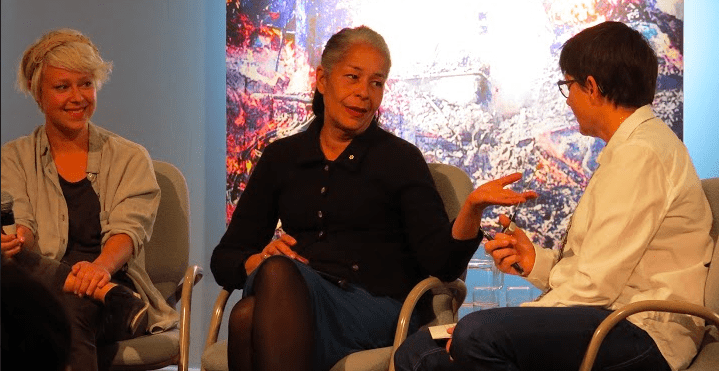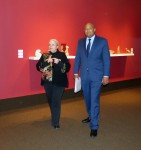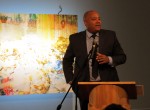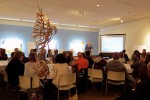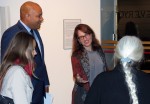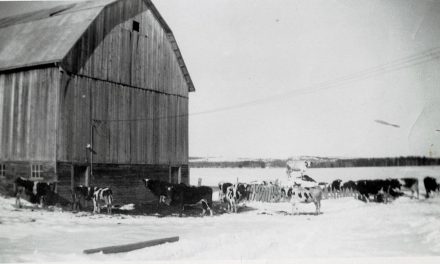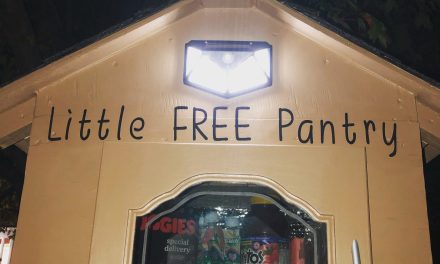Story by Nancy Saunders, Photos by Alastair Mackay
On October 22, the Thunder Bay Art Gallery was host to one of eleven “Culture Talks Town Hall” sessions happening across the province between now and December. Through these sessions the Ontario Ministry of Tourism, Culture and Sport aims to “engage citizens and gather public input” for the development of Ontario’s first Culture Strategy. The new strategy will “set a vision for arts and culture, define priorities and guide support for the sector in the years to come.”
The evening session was attended by over 100 people of all ages from the local arts and culture community, and was facilitated by Toronto-based urban activist and community organizer Jane Farrow. Thunder Bay visual artist Lora Northway, who is the Youth Outreach Coordinator for Definitely Superior Art Gallery and founder of the Die Active Art Collective and Neechee Studio for Aboriginal Youth, was a guest speaker, along with Canadian musical icon Molly Johnson.
Under the Ministry’s umbrella are four culture sectors: the arts, including craft, dance, literary arts, media arts, music, opera, theatre, and visual arts; cultural industries, including film and television production, interactive digital media (e.g., video games, apps), the music industry, and book and magazine publishing; public libraries; and cultural heritage, including built heritage, cultural heritage landscapes, archaeology, and museums.
Local residents representing each category were in attendance to speak about the importance of community engagement in arts and culture and about what culture means to them, including visual artists Elizabeth Buset, Aaron Veldstra, and Susan Kachor Conlon (whose art is currently on display until January); filmmaker Michelle Desrosiers; Gerald Graham of the Sleeping Giant Folk Music Society; Thunder Bay Public Library Chief Librarian/CEO, John Pateman; Aboriginal artists Ryan and Shannon Gustafson; and Dr. Tory Tronrud, Director and Curator of the Thunder Bay Museum, who is part of the 17-person provincial Culture Strategy Advisory Group that will provide advice to the government on the culture strategy.
Thunder Bay Art Gallery director Sharon Godwin was pleased by the turnout. “Our community is so vibrant. There are a lot of young people here, and so many familiar faces. People really step up in Thunder Bay and get involved.”
When asked if the culture strategy will be one-size-fits-all for all areas of the province, Minister Michael Coteau acknowledged Northern Ontario’s unique challenges. “That’s exactly why we’re out here, to hear those types of considerations, like access. When you’re running a program in Thunder Bay with a large catchment area, transportation may be an issue. There are different challenges and it’s important for us to make sure that our funding, the way in which our policies and directives are built, are aligned with the flexibility that allows communities to really leverage that type of funding to meet their needs locally.”
Lora Northway shared her thoughts on the role the arts plays in the lives of youth, as well as successes and challenges as an artist on Ontario. “There’s something surreal about defending arts and culture, but we need to. Culture is life-enhancing, defines our personal and national identities, and is important to all of us.” Northway’s personal experience as an artist helped her to “find out who I was, and learn to love myself.” Die Active Art Collective, which mentors and supports emerging young artists with over 540 members ranging in age from 14 to 30, is important, explains Northway, “because it lets youth see ourselves in the city we live in… This structure of creating together, learning from each other, sharing it and watching it change us is powerful. Other generations can understand us, hear our voice, and better appreciate us.”
Northway emphasized that youth should be given more opportunities to receive funding and resources. They need to be empowered and given the chance to access the tools necessary for success as artists. “Arts organizations need guaranteed core funding. Without a platform like DefSup, youth culture would be non-existent in this community”, as the artist-run gallery is the portal through which the youth programs are run. “Culture is shaped by its participants… We need to fund existing structures that work, and open new funding opportunities for youth-led initiatives. Structures around art and culture can sometimes be exclusionary and intimidating; we have to drop expectations and stereotypes, and respect youth by giving them authentic support, getting them involved in all parts of the process.”
Culture is one of the fastest growing sectors in Ontario. It generates approximately $22 billion of Ontario’s GDP and supports more than 280,000 jobs. Ontario has over 58,000 artists – nearly twice as many as any other province. Research shows that participation in arts and culture improves confidence and physical and mental health; engagement in arts and culture is linked to improved social and problem-solving skills and higher academic achievement.
“Thunder Bay is hungry for arts and culture opportunities,” says Northway. “We get a lot out of them, and often we have to build them ourselves with challenging conditions, but life here in meaningful. A great deal of our culture is formed by our hands, and felt just by spending time in our environment.”
Musician Molly Johnson chose to speak at the session in Thunder Bay partly because she has fond memories of visiting the city years ago and spending time boating on Lake Superior. “I like it here. It’s just the right-sized city. And now I see how much is going on here with the arts. We need to share this art across Ontario.” She echoed Northway’s desire for greater connectivity across the province to promote increased collaboration and dialogue between artists.
Godwin is positive about Thunder Bay’s chance to be heard. “There are enough people here that if things don’t happen, they will ask questions, do work, and ensure accountability. It’s really important that this discussion was initiated by the province, and that Minister Coteau was here until the end.”
Click here to read more about the guiding principles for Ontario’s Culture Strategy.
There are three ways to participate and provide your input for the Culture Strategy: online through Culture Talks, an interactive platform that lets you share your thoughts, discuss with other participants, and vote on others’ ideas; in-person at a town hall; or leaving a comment online on the discussion paper.
All input must be submitted by December 7, 2015. In 2016, the Ministry will release a report highlighting the key themes they heard in the public consultations, before posting a draft strategy for public input.
- The AG’s Sharon Godwin and Minister Michael Coteau
- Minister Michael Coteau


